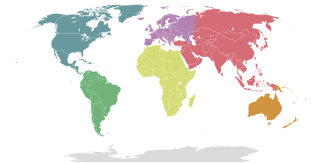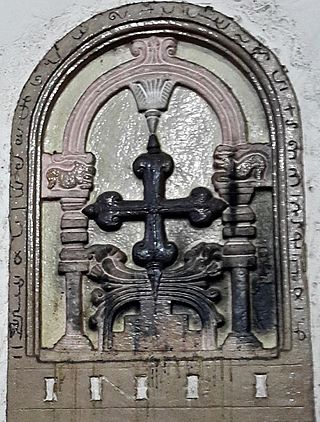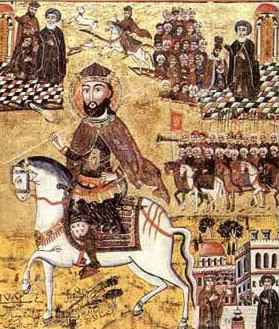Related Research Articles
Nestorianism is a term used in Christian theology and Church history to refer to several mutually related but doctrinarily distinct sets of teachings. The first meaning of the term is related to the original teachings of Christian theologian Nestorius, who promoted specific doctrines in the fields of Christology and Mariology. The second meaning of the term is much wider, and relates to a set of later theological teachings, that were traditionally labeled as Nestorian, but differ from the teachings of Nestorius in origin, scope and terminology. The Oxford English Dictionary defines Nestorianism as:
"The doctrine of Nestorius, Patriarch of Constantinople, by which Christ is asserted to have had distinct human and divine persons."

The persecution of Christians can be historically traced from the first century of the Christian era to the present day. Christian missionaries and converts to Christianity have both been targeted for persecution, sometimes to the point of being martyred for their faith, ever since the emergence of Christianity.

Yazdegerd I was the Sasanian King of Kings of Iran from 399 to 420. A son of Shapur III, he succeeded his brother Bahram IV after the latter's assassination.

The Assyrian Church of the East (ACOE), sometimes called the Church of the East and officially known as the Holy Apostolic Catholic Assyrian Church of the East (HACACE), is an Eastern Christian church that follows the traditional Christology and ecclesiology of the historical Church of the East. It belongs to the eastern branch of Syriac Christianity, and employs the Divine Liturgy of Saints Addai and Mari belonging to the East Syriac Rite. Its main liturgical language is Classical Syriac, a dialect of Eastern Aramaic, and the majority of its adherents are ethnic Assyrians who speak differing Akkadian influenced dialects of Eastern Aramaic in everyday life.

Christianity in Iran dates back to the early years of the religion during the time of Jesus. Through this time the Christian faith has always been followed by a minority of the population of Iran under its different state religions: Zoroastrianism in historical Persia, followed by Sunni Islam in the Middle Ages after the Arab conquest, then Shia Islam since the Safavid conversion of the 15th century. However, Christians comprised a larger share of the population in the past than they do today. Iranian Christians have played a significant part in the historical Christian mission: currently, there are at least 600 churches and 300,000–370,000 converts.

The Chaldean Syrian Church of India is an Eastern Christian denomination, based in Thrissur, in India. It is organized as a metropolitan province of the Assyrian Church of the East, and represents traditional Christian communities of the East Syriac Rite along the Malabar Coast of India. It is headed by Mar Awgin Kuriakose.

Saint Anastasius of Persia, also known by his native name Magundat, was a Zoroastrian soldier in the Sasanian army who later became a convert to Christianity and was martyred in 628.

Mar Shimun Bar Sabbae was the Chaldean Bishop of Seleucia-Ctesiphon, from Persia, the de facto head of the Church of the East, until his death. He was bishop during the persecutions of King Shapur II of the Sasanian Empire of Iran, and was executed along with many of his followers. He is revered as a saint in various Christian communions.

Asoristan was the name of the Sasanian province of Assyria and Babylonia from 226 to 637.
Christianity began as a Second Temple Judaic sect in the 1st century in the Roman province of Judea, from where it spread throughout and beyond the Roman Empire.

The Council of Seleucia-Ctesiphon, also called the Council of Mar Isaac, met in AD 410 in Seleucia-Ctesiphon, the capital of the Persian Sassanid Empire. Convoked by King Yazdegerd I (399–421), it organized the Christians of his empire into a single structured Church, which became known as the Church of the East. It is often compared to Constantine's Edict of Milan, approximately a century earlier. The events of this council are documented in the Synodicon Orientale.

The Church of the East or the East Syriac Church, also called the Church of Seleucia-Ctesiphon, the Persian Church, the Assyrian Church, the Babylonian Church or the Nestorian Church, is one of three major branches of Nicene Eastern Christianity that arose from the Christological controversies in the 5th century and the 6th century, alongside that of Miaphysitism and the Chalcedonian Church.

Metropolitanate of India was an East Syriac ecclesiastical province of the Church of the East, at least nominally, from the seventh to the sixteenth century. The Malabar region (Kerala) of India had long been home to a thriving Eastern Christian community, known as the Saint Thomas Christians. The community traces its origins to the evangelical activity of Thomas the Apostle in the 1st century. The Christian communities in India used the East Syriac Rite, the traditional liturgical rite of the Church of the East. They also adopted some aspects of Dyophysitism of Theodore of Mopsuestia, often inaccurately referred as Nestorianism, in accordance with theology of the Church of the East. It is unclear when the relation between Saint Thomas Christian and the Church of the East was established. Initially, they belonged to the metropolitan province of Fars, but were detached from that province in the 7th century, and again in the 8th, and given their own metropolitan bishop.

Saints Behnam, Sarah, and the Forty Martyrs were 4th-century Assyrian Christians who suffered martyrdom during the reign of Shapur II. They are venerated as saints in the Assyrian Church of the East and Oriental Orthodox Churches.
George of Izla was an East Syriac martyr, theologian and interpreter. He was mainly remembered for his role in a royal disputation which eventually led to his execution.
Ēḻarappaḷḷikaḷ or Ezharappallikal, are the seven major churches or Christian communities of Saint Thomas Christians across Malabar Coast of India that are believed to have been founded by Thomas the Apostle in the first century. According to Indian Christian traditions, the apostle Thomas arrived in Muziris (Kodungallur) in AD 52, established the Ezharappallikal and evangelised in present-day Kerala and Tamil Nadu. Many of these churches built near Jewish and Brahmin settlements. These were at Maliankara (Kodungallur), Kollam, Palayoor, Kottakkayal, Kokkamangalam, Niranam and Nilackal (Chayal). Thiruvithamcode church in Kanyakumari was built on the land given by arachan (king) and hence it is often referred in the name Arappally. Similarly, the Churches at Malayattoor and Aruvithura are also referred to as Arappallikal.
The Acts of Pusai or Martyrdom of Pusai is a Syriac narrative about the martyrdom of a Christian saint named Pusai. English-speaking literature refers to this work by a variety of names, including the Martyrdom of Pusai-Qarugbed, on account of Pusai's title Qarugbed, "Head of the Craftsmen", and as the "Martyrdom of Pusay. Other variants include Acts of Mar Pusai and the Passions of Pusay.

The Chronicle of Arbela claims to record the early history of Christianity in Arbela, then the capital of Adiabene, from the early second century to the mid-sixth century. It appears to date to the sixth century, though its age and historicity have been disputed. Today, the majority of specialists consider the work to be a modern forgery.
The History of Mar Qardagh is a Syriac martyrdom text pertaining to Qardagh, a Sasanian military leader and noble who converted from Zoroastrianism to Christianity. Though the narrative of the text is set during the reign of Shapur II, it was written in the final decades of the Sasanian Empire.
References
- ↑ Joel Walker (25 March 2006). The Legend of Mar Qardāgh: Narrative and Christian Heroism in Late Antique Iraq. University of California Press. ISBN 978-0-520-93219-7.
- 1 2 3 Mār Qardāgh Archived 2011-11-29 at the Wayback Machine , St. Peter The Apostle Catholic Diocese for Chaldeans.